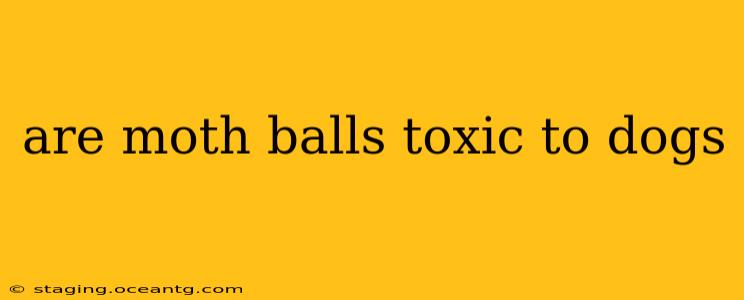Mothballs, those pungent little spheres used to deter insects, pose a significant threat to our canine companions. The answer is a resounding yes, mothballs are toxic to dogs. Their toxicity stems from the chemical compounds they contain, primarily naphthalene and paradichlorobenzene. Ingestion or even inhalation of these chemicals can lead to serious health problems, even death. This guide will delve into the dangers, symptoms, and preventative measures to ensure your dog's safety.
What Makes Mothballs Dangerous for Dogs?
Mothballs are toxic because of their active ingredients: naphthalene and paradichlorobenzene. These are volatile organic compounds, meaning they readily evaporate into the air. Dogs, with their keen sense of smell and tendency to explore their environment with their mouths, are particularly vulnerable.
-
Naphthalene: This compound is known to cause hemolytic anemia, a condition where red blood cells are destroyed prematurely. This can lead to weakness, lethargy, and even death.
-
Paradichlorobenzene: This chemical can irritate the eyes, skin, and respiratory tract. Ingestion can cause gastrointestinal upset, including vomiting and diarrhea. In severe cases, it can affect the liver and kidneys.
What Happens if My Dog Eats a Mothball?
The severity of the effects depends on several factors, including the size of the dog, the number of mothballs ingested, and the specific chemical composition. Symptoms can manifest quickly or develop over time.
Immediate Symptoms:
- Vomiting: This is a common sign of ingestion.
- Diarrhea: Often accompanied by vomiting.
- Lethargy: A noticeable decrease in energy levels.
- Weakness: Difficulty standing or walking.
- Tremors: Uncontrollable shaking.
- Seizures: In severe cases.
Delayed Symptoms:
- Jaundice: Yellowing of the skin and whites of the eyes, indicating liver damage.
- Dark urine: Another sign of liver problems.
- Pale gums: Indicative of anemia.
- Respiratory distress: Difficulty breathing.
How to Treat Mothball Poisoning in Dogs
If you suspect your dog has ingested a mothball, immediate veterinary attention is crucial. Do not attempt to induce vomiting or administer any home remedies without consulting a veterinarian. They will conduct a thorough examination, diagnose the severity of the poisoning, and determine the appropriate treatment, which may include:
- Activated charcoal: To absorb the toxins in the dog's system.
- Intravenous fluids: To support kidney and liver function.
- Oxygen therapy: To assist with breathing difficulties.
- Supportive care: To manage symptoms and aid recovery.
What to Do If Your Dog Shows Signs of Mothball Poisoning
- Remove any remaining mothballs from your dog's reach. This prevents further ingestion.
- Contact your veterinarian or an animal poison control center immediately. Provide them with details about the incident, including the type and quantity of mothballs ingested, your dog's size and breed, and any symptoms observed.
- Follow your veterinarian's instructions carefully. Prompt and appropriate treatment is vital for a positive outcome.
- Transport your dog to the nearest veterinary clinic if necessary.
How Can I Prevent My Dog from Ingesting Mothballs?
Prevention is always better than cure. To protect your dog from mothball poisoning:
- Store mothballs in tightly sealed containers, out of your dog's reach. High shelves or locked cabinets are ideal.
- Use alternative pest control methods. Cedar chips, lavender sachets, or commercially available pet-safe insect repellents offer safer alternatives.
- Keep your home clean and clutter-free. This reduces the chances of your dog finding and ingesting anything harmful.
- Educate family members and guests about the dangers of mothballs to pets.
Are there pet-safe alternatives to mothballs?
Yes, absolutely! There are numerous safer alternatives to mothballs for repelling moths and other insects. These include cedar chips, lavender sachets, sachets filled with dried herbs like rosemary or thyme, and commercially available pet-safe insect repellents. Many of these options offer a more natural and less toxic approach to pest control.
What if my dog only sniffed mothballs?
While ingestion is the most serious concern, inhalation of mothball fumes can still cause irritation to your dog's respiratory system. If you notice any signs of respiratory distress, such as coughing, sneezing, or difficulty breathing, consult your veterinarian immediately. Even if there's no apparent immediate reaction, it's best to keep a close eye on your dog and contact your veterinarian if you have any concerns.
By understanding the risks and taking appropriate precautions, you can effectively protect your canine companion from the dangers of mothballs. Remember, prevention is key, and prompt veterinary care is essential in case of accidental ingestion.
